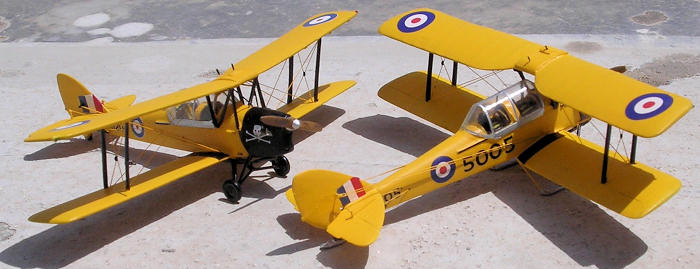
Pavla 1/72 Tiger Moth
| KIT #: | ? |
| PRICE: | ? |
| DECALS: | Three options |
| REVIEWER: | Carmel J. Attard |
| NOTES: | Short run with vacuformed canopy |

| HISTORY |
The
Tiger Moth was developed from the De Havilland Moth civilian trainer, and upon
modification to the basic design it became to be known as DH 82 Tiger Moth. It
flew on 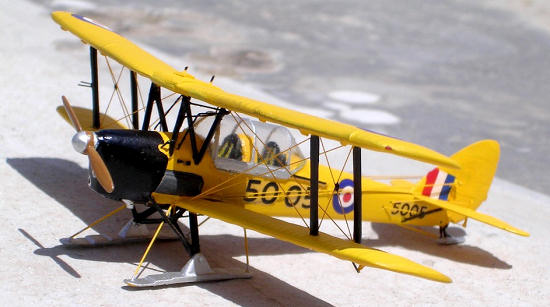 was sold to several countries.
was sold to several countries.
| THE KIT |
The Pavla kit of the DH82C Tiger Moth Mk1 is another kit that was very welcomed as it is the most accurate kit of its type at a scale of 1/72. The kit comes in medium grey injection moulded plastic, which has fine surface detail, and there are also resin parts for the instrument panels, detailed mid wing fuel tank, main skids and alternative undercarriage. There are colourful side views on the Box cover depicting two of the three decal obtions offered. Data on the side box also states that the construction kit contain photo etch parts however I could not find any and the instruction sheet inside made no reference to it either. So Pavla has to correct this slight misinformation.
| CONSTRUCTION |
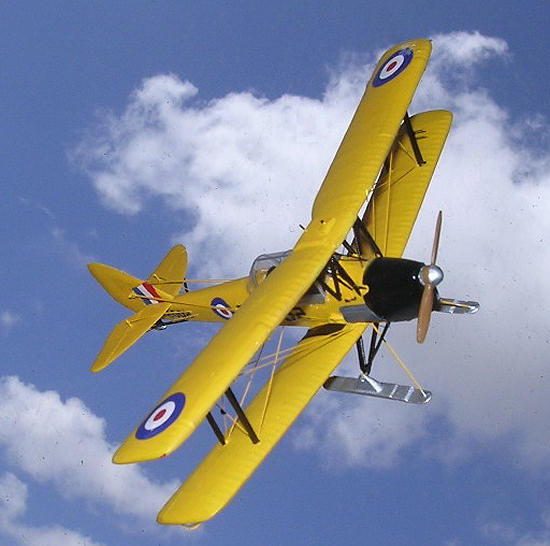 The assembly starts with
the cockpit area and there are sufficient parts to make it complete. I added
seat straps to the two seats and preferred to drill through the various
instruments using different size drills as I envisaged that the detail added
would be quite visible from the clear vac-form canopy that comes with the kit.
The wing tip bullet shaped tiny lights comes in small resin pieces and I drilled
a small locating hole before I glued these in their respective place.
The assembly starts with
the cockpit area and there are sufficient parts to make it complete. I added
seat straps to the two seats and preferred to drill through the various
instruments using different size drills as I envisaged that the detail added
would be quite visible from the clear vac-form canopy that comes with the kit.
The wing tip bullet shaped tiny lights comes in small resin pieces and I drilled
a small locating hole before I glued these in their respective place.
As there are two cockpit
canopies in the kit pack, with one being spare, then you can save the surplus
one and modify an old Airfix kit to the Mk 82C standard. This entails more than
just fitting the new cockpit layout since the cowling is much broader and the
Airfix kit fuselage has to broaden all along besides being enlarged at the
front. The same thing applies to the trailplanes and fin and rudder which are
far too small when compared to the Pavla offering. Best thing I found was to
discard the Airfix ones and build new ones from plastic card using the Pavla kit
ones as template. There are also other minor alterations to the u/c strut and
wings thickness. Using the Pavla kit as reference it was possible in my case to
upgrade the Airfix kit as well. In my opinion this is the true art of scale
aircraft modelling after all.
*The seats should move forward to the position shown on their
base plate section 7.
*The two instrument panels should be fixed slightly raised from the coaming.
*The rudder may or may not have a trim tab and one need to check with the artwork on the box cover.
·
The pivot strut and drag
strut could have been made in one piece and the ‘N’strut could have been moulded
with side locating pins to simplify assembly.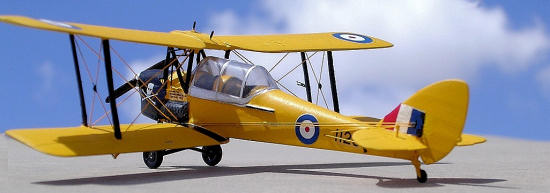
· To the central wing assembly a fuel tank sump and gravity feed pipe was added out of metal wire, which was bent to shape and cut to size.
· When fixing the instrument venturi to each side of the cowling I predrilled locating holes in order to locate them in place without difficulty.
· Other small items added was the rudder operating lever and the elevator lever. Drilled through the fuselage sides to allow the elevator cables to pass through. Also added the pitot static twin tube to the starboard interplane strut. The rudder cables were added using invisible thread.
The decals with Pavla are top quality as far as register goes. My only reservation is that the white areas of the fin flash and roundels was not sufficiently opaque and one either has to replace the roundels etc with another set or in my case I slid them first on white decal sheet and cut them so that the combination arrangement gave a better result.
| COLORS & MARKINGS |
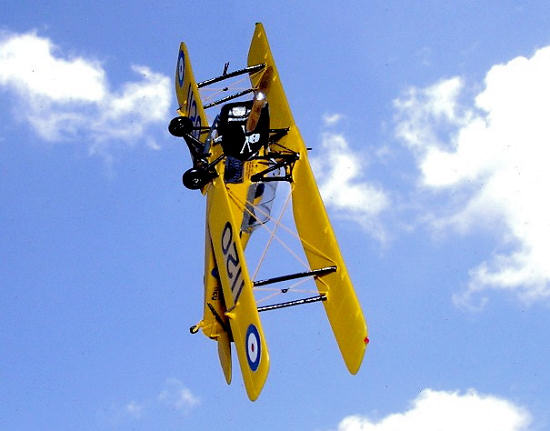 There
are sufficient items to enable to complete the Tiger Moth in any one of the
following schemes:
There
are sufficient items to enable to complete the Tiger Moth in any one of the
following schemes:
a) A DH82C No 1120 of the 31EFTS in De Winton, Canada. That was used for first training courses to Czech student pilots till the end o1942. The aircraft is overall yellow with a black cowling and a skull and cross bones motif on the nose on both sides.
b) A scheme that represents a DH82C of No5005 of the school of Saskatchewan province that like the previous one is overall trainer yellow FS23538 and a black cowling. It has a ski undercarriage, which makes a difference to the normal one fitted with wheels.
c) The third choice if one that also belongs to one of the pilots school in Canada. It carries a series of regular black stripes on the fuselage and inner wings area at top and bottom on an otherwise standard scheme of trainer yellow and with a black cowling. The cowling also carries a neatly printed shark mouth.
| CONCLUSIONS |
The Pavla kit of the DH
82C turned into another pleasing biplane of an aircraft still flying in several
parts of
If you would like your product reviewed fairly and fairly quickly, please contact the editor or see other details in the Note to Contributors.